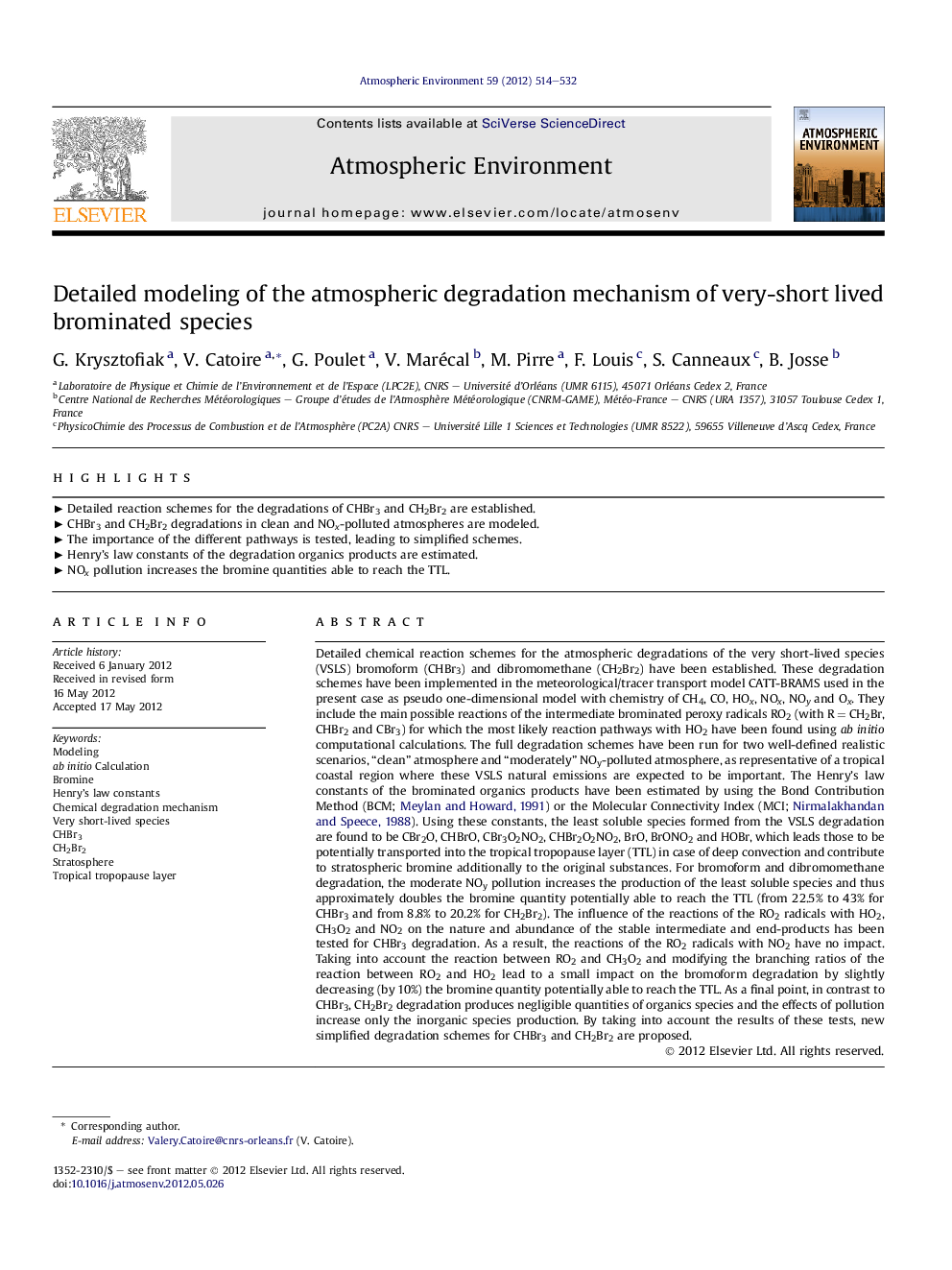| کد مقاله | کد نشریه | سال انتشار | مقاله انگلیسی | نسخه تمام متن |
|---|---|---|---|---|
| 6342431 | 1620412 | 2012 | 19 صفحه PDF | دانلود رایگان |

Detailed chemical reaction schemes for the atmospheric degradations of the very short-lived species (VSLS) bromoform (CHBr3) and dibromomethane (CH2Br2) have been established. These degradation schemes have been implemented in the meteorological/tracer transport model CATT-BRAMS used in the present case as pseudo one-dimensional model with chemistry of CH4, CO, HOx, NOx, NOy and Ox. They include the main possible reactions of the intermediate brominated peroxy radicals RO2 (with RÂ =Â CH2Br, CHBr2 and CBr3) for which the most likely reaction pathways with HO2 have been found using ab initio computational calculations. The full degradation schemes have been run for two well-defined realistic scenarios, “clean” atmosphere and “moderately” NOy-polluted atmosphere, as representative of a tropical coastal region where these VSLS natural emissions are expected to be important. The Henry's law constants of the brominated organics products have been estimated by using the Bond Contribution Method (BCM; Meylan and Howard, 1991) or the Molecular Connectivity Index (MCI; Nirmalakhandan and Speece, 1988). Using these constants, the least soluble species formed from the VSLS degradation are found to be CBr2O, CHBrO, CBr3O2NO2, CHBr2O2NO2, BrO, BrONO2 and HOBr, which leads those to be potentially transported into the tropical tropopause layer (TTL) in case of deep convection and contribute to stratospheric bromine additionally to the original substances. For bromoform and dibromomethane degradation, the moderate NOy pollution increases the production of the least soluble species and thus approximately doubles the bromine quantity potentially able to reach the TTL (from 22.5% to 43% for CHBr3 and from 8.8% to 20.2% for CH2Br2). The influence of the reactions of the RO2 radicals with HO2, CH3O2 and NO2 on the nature and abundance of the stable intermediate and end-products has been tested for CHBr3 degradation. As a result, the reactions of the RO2 radicals with NO2 have no impact. Taking into account the reaction between RO2 and CH3O2 and modifying the branching ratios of the reaction between RO2 and HO2 lead to a small impact on the bromoform degradation by slightly decreasing (by 10%) the bromine quantity potentially able to reach the TTL. As a final point, in contrast to CHBr3, CH2Br2 degradation produces negligible quantities of organics species and the effects of pollution increase only the inorganic species production. By taking into account the results of these tests, new simplified degradation schemes for CHBr3 and CH2Br2 are proposed.
⺠Detailed reaction schemes for the degradations of CHBr3 and CH2Br2 are established. ⺠CHBr3 and CH2Br2 degradations in clean and NOx-polluted atmospheres are modeled. ⺠The importance of the different pathways is tested, leading to simplified schemes. ⺠Henry's law constants of the degradation organics products are estimated. ⺠NOx pollution increases the bromine quantities able to reach the TTL.
Journal: Atmospheric Environment - Volume 59, November 2012, Pages 514-532